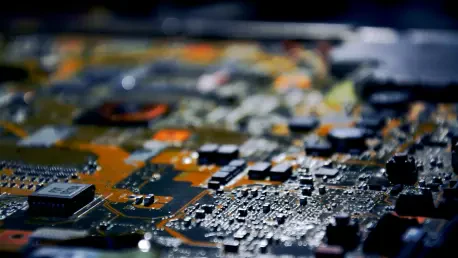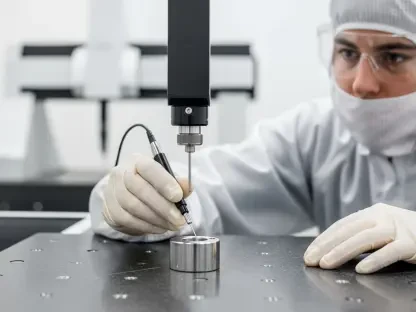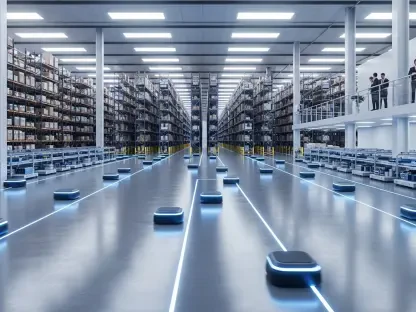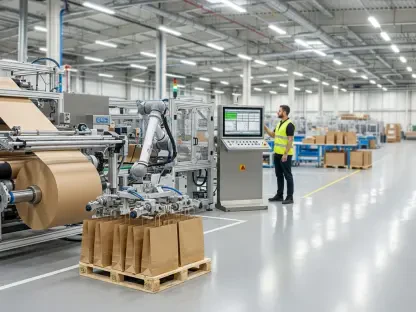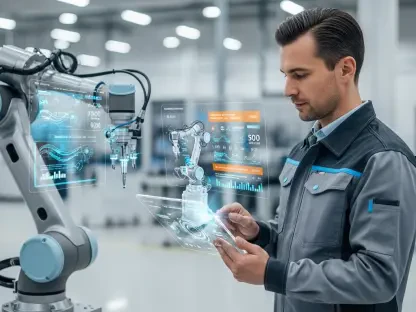In an era where technology evolves at a breathtaking pace, artificial intelligence (AI) has emerged as a transformative force in the semiconductor industry, ushering in what experts call the “AI Supercycle.” This phenomenon represents a powerful, self-reinforcing loop where AI not only relies on cutting-edge hardware for its operation but also plays a pivotal role in designing and manufacturing the very chips that fuel its growth. The result is a seismic shift in how semiconductors are developed, with innovation accelerating at unprecedented rates, costs dropping significantly, and performance reaching new heights. This cycle is redefining the boundaries of technological progress, placing the semiconductor sector at the epicenter of a broader digital revolution. Beyond the technical realm, the implications ripple through global economies, geopolitical strategies, and even environmental considerations, as AI-driven advancements promise to address some of the most pressing challenges of modern computing. As companies across the spectrum race to integrate AI into their workflows, the stakes have never been higher, with the potential to reshape entire industries on the line.
The Driving Force of the AI Supercycle
The concept of the “AI Supercycle” encapsulates a groundbreaking dynamic in the semiconductor world, where AI advancements propel improvements in chip technology, and those enhanced chips, in turn, enable even more sophisticated AI models. This virtuous cycle drastically compresses development timelines, with AI-powered tools cutting the time needed to design and produce chips from what once took months or even years down to just weeks in certain scenarios. Such speed is not merely a convenience but a game-changer, allowing companies to iterate rapidly and bring cutting-edge solutions to market faster than ever before. The supercycle also amplifies efficiency, as AI optimizes critical metrics like power, performance, and area (commonly referred to as PPA), ensuring that chips are not only faster to develop but also smarter in design. By predicting potential flaws and refining architectures with a level of precision unattainable through traditional human-led methods, AI is setting a new standard for what hardware can achieve, meeting the escalating demands of modern AI applications with remarkable agility.
Beyond the acceleration of timelines, the AI Supercycle signifies a profound shift in the very nature of innovation within the industry. AI tools analyze vast datasets to uncover design optimizations that would be impossible for human engineers to identify manually, leading to chips that are more energy-efficient and tailored to specific workloads. This capability is particularly crucial as AI applications expand into diverse fields such as autonomous systems, edge computing, and large-scale cloud infrastructure, each requiring specialized hardware. The ripple effects of this cycle extend to cost reductions, as streamlined processes lower the financial barriers to entry for cutting-edge technology development. As a result, the semiconductor landscape is becoming increasingly competitive, with players who harness this supercycle gaining a significant edge. This dynamic is not just reshaping how chips are made but also redefining the strategic priorities of tech companies worldwide, positioning AI as both a driver and beneficiary of hardware evolution.
Reinventing Chip Design with AI
At the heart of the semiconductor transformation lies the profound impact of AI on the design phase, where creativity and precision are being redefined by advanced technologies. Electronic Design Automation (EDA) tools, now infused with AI capabilities, are automating intricate and labor-intensive tasks that once consumed countless engineering hours. This automation frees up human designers to focus on conceptual innovation rather than getting bogged down in repetitive details. Generative AI takes this a step further by exploring an almost infinite array of design possibilities, rapidly generating chip architectures optimized for specific goals like minimal power usage or maximum processing speed. These tools enable the creation of hardware that is not only more efficient but also finely tuned to the unique demands of modern applications, from mobile devices to data centers, marking a significant departure from the slower, more manual design processes of the past.
Equally transformative is AI’s role in simulation and verification, critical steps that ensure a chip’s performance before it ever reaches production. By modeling chip behavior at an incredibly granular level, AI reduces the reliance on costly physical prototypes, which traditionally extended R&D cycles and inflated expenses. This digital-first approach allows for early detection of design flaws, ensuring that issues are addressed long before they become expensive problems. The result is a dramatic shortening of development timelines and a boost in design accuracy, with many projects achieving near-flawless outcomes on the first attempt. This efficiency not only saves resources but also accelerates the pace at which new technologies can be brought to market, giving companies a critical advantage in a fast-moving industry. AI’s integration into design is thus not just an enhancement but a complete reimagining of how semiconductor innovation unfolds.
Precision and Efficiency in Manufacturing
AI’s influence extends powerfully into the manufacturing realm, where it drives unparalleled precision and operational efficiency in semiconductor production. By leveraging real-time data analysis, AI systems can detect microscopic defects during fabrication that would escape even the most meticulous human inspection. These systems also predict equipment failures before they occur, enabling proactive adjustments that prevent costly disruptions. The impact on yields is staggering, with some manufacturers reporting improvements of up to 30% thanks to AI-driven insights. Such advancements mark a stark contrast to older, less precise methods that often resulted in higher waste and lower output, highlighting how AI is revolutionizing the factory floor into a hub of data-driven decision-making that maximizes both quality and quantity.
Another critical benefit of AI in manufacturing lies in its ability to minimize downtime through predictive maintenance, a game-changer in an industry where equipment costs are astronomical. By forecasting when machinery might fail and scheduling maintenance during optimal windows, AI ensures that production lines keep running smoothly, avoiding the expensive halts that plague traditional setups. This capability translates directly into cost savings, as reduced downtime and higher yields lower the overall expense of producing advanced chips. Furthermore, the environmental footprint of manufacturing benefits from these efficiencies, as less waste and optimized energy use align with growing sustainability demands. The integration of AI into production processes is thus creating a more resilient and cost-effective ecosystem, positioning manufacturers to meet the soaring global demand for semiconductors with unprecedented agility.
Market Dynamics and Competitive Advantages
The adoption of AI in semiconductor processes is fundamentally altering the competitive landscape, creating clear distinctions between industry leaders and laggards. Established giants like Synopsys and Cadence Design Systems are cementing their dominance by integrating AI into their EDA tools, offering solutions that drastically outpace traditional approaches in speed and efficiency. Meanwhile, major tech players such as NVIDIA, Google, and Apple are leveraging AI to design custom chips tailored to their specific AI workloads, optimizing performance for everything from cloud computing to edge devices. This strategic use of AI not only enhances their product offerings but also positions them at the forefront of innovation, setting a high bar for competitors who must adapt or risk falling behind in a rapidly evolving market.
Emerging players are also making waves, with startups focusing on niche AI-driven tools or novel chip architectures challenging the status quo. These smaller entities have the potential to disrupt entrenched companies by offering specialized solutions that address specific pain points in design or manufacturing. The stakes of this transformation are immense—firms that fail to embrace AI risk obsolescence as rapid iteration and energy-efficient hardware become critical differentiators. This shift could lead to a consolidation of power among those who master AI integration, reshaping market dynamics and potentially sidelining players reliant on slower, outdated development cycles. The competitive pressure underscores a broader truth: in the age of the AI Supercycle, adaptability is not just an asset but a prerequisite for survival and success in the semiconductor industry.
Global Implications and Future Horizons
The ramifications of AI’s role in semiconductors extend far beyond the confines of the tech sector, influencing global trends in economics, geopolitics, and sustainability. Economically, the AI Supercycle is projected to drive semiconductor sales to staggering heights, with estimates suggesting the market could reach $1 trillion by 2030. This growth fuels profitability for companies at the forefront of AI adoption and attracts massive investments into manufacturing capacity. Geopolitically, AI enhances supply chain resilience by optimizing logistics and predicting shortages, a vital capability in an era of frequent disruptions. Environmentally, AI-optimized chips reduce power consumption, addressing the escalating energy demands of AI workloads and aligning with global efforts to combat climate change, thus positioning the industry as a key player in sustainable innovation.
Looking to the future, the trajectory of AI in semiconductors points toward even deeper integration, with generative AI expected to streamline the creation of application-specific integrated circuits (ASICs) for diverse uses like IoT and autonomous systems. Fully autonomous manufacturing facilities, guided by AI systems, are on the horizon, promising to further reduce costs and human error. Challenges remain, including the need for governance to ensure design integrity and the development of explainable AI to demystify critical decisions. Yet, the vision is clear: a world of self-optimizing hardware, continuously refined by AI using real-world data, stands poised to democratize innovation. Reflecting on this journey, the strides made through the AI Supercycle have already laid a robust foundation, and the focus now shifts to harnessing these advancements to tackle emerging challenges and unlock untapped potential in technology’s next frontier.
